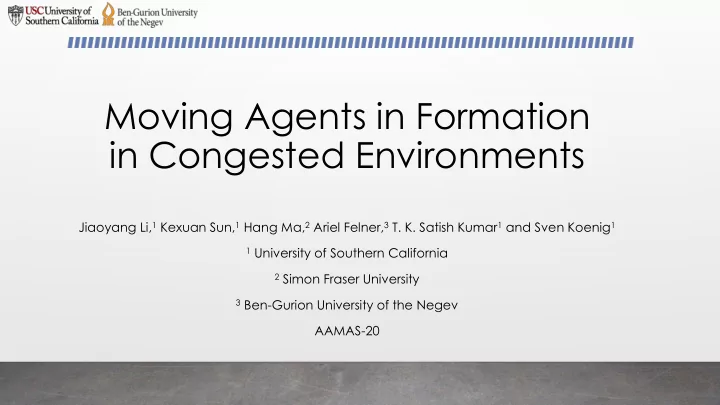

Moving Agents in Formation in Congested Environments Jiaoyang Li, 1 Kexuan Sun, 1 Hang Ma, 2 Ariel Felner, 3 T. K. Satish Kumar 1 and Sven Koenig 1 1 University of Southern California 2 Simon Fraser University 3 Ben-Gurion University of the Negev AAMAS-20
2 Motivation Figure sources: [1] https://en.wikipedia.org/wiki/Cossacks:_European_Wars#/media/File:3_cossacks_european_wars.JPG [2] https://futureoflife.org/wp-content/uploads/2019/04/Why-ban-lethal-AI-1030x595.jpg
3 Motivation Figure source: [1] Renato Silveira, Edson Prestes e Silva Jr., Luciana Porcher Nedel. Managing coherent groups. Journal of Visualization and Computer Animation 19(3-4): 295-305 (2008).
4 Overview • Moving agents in formation • Definition • Related work • SWARM-MAPF • Choose a leader • Partition the leader’s path into segments and plan paths for each segment • Experiments
5 Problem Definition • Inputs • An undirected graph • 𝑁 agents, each with • a start location, • a goal location. • Output • A set of collision-free paths, one for each agent.
6 Problem Definition • Formation • The formation of the agents at timestep 𝑢 is specified by the coordinates of the locations of all agents at timestep 𝑢 . • The desired formation is specified by the coordinates of the goal locations.
7 Formation Deviation • The formation deviation ℱ 𝑢 captures the least effort required for the agents to move from their current formation to their desired formation when ignoring obstacles on the map and collisions between agents. 𝑁 ℱ 𝑢 = min 𝚬𝐲 𝐯 𝐣 − 𝐰 𝐣 + 𝚬𝐲 1 𝑗=1 where • 𝐯 𝐣 = the coordinate of the location of agent 𝑏 𝑗 in the current formation, • 𝐰 𝐣 = the coordinate of the location of agent 𝑏 𝑗 in the desired formation.
8 Objective • The quality of a solution is evaluated by • Its makespan and • Its total formation deviation σ 𝒖 ℱ 𝑢 .
9 Related Work Two key tasks Planning collision-free Keeping agents in paths for multiple agents formation Multi-Agent Path Finding (MAPF) in AI: Formation control in Robotics: - Conflict-Based Search - Leader-follower methods - A* in joint-state space - Potential-field methods - Reduction-based methods - Behavior-based methods - Priority-based methods - Virtual-structure methods - Rule-based methods - … - …
10 SWARM-MAPF 1. Choose a leader among the agents. 2. Partition the leader’s path into open and congested segments. • For each open segment, plan paths by a leader-follower method. • For each congested segment, plan paths by a MAPF method.
11 SWARM-MAPF x x x 1. Choose a leader formation-blocking location! Number of formation-blocking locations = 3 1 2 3
12 SWARM-MAPF 1. Choose a leader a. For each agent, find a short path that minimizes the number of formation-blocking locations. b. Choose the agent as the leader whose path has the minimum number of formation-blocking locations. x x x x x x x x x x x x
13 SWARM-MAPF 2. Partition the leader’s path into segments formation formation blocking blocking Leader’s path open congested congested open segment segment segment segment open segment • Open segment: Ask all agents to follow the leader’s path in the desired formation. • Congested segment: Call a (modified) MAPF solver to plan collision-free paths.
14 SWARM-MAPF Congested segment: • We use CBS-M, a modified CBS [Sharon et al., 2015], to solve the sub-instance: • CBS-M is guaranteed to find collision-free paths with the minimum makespan. • CBS-M break ties by preferring paths with smaller total formation deviations in both its high- and low-level searches. [1] Guni Sharon, Roni Stern, Ariel Felner, and Nathan R. Sturtevant. 2015. Conflict-Based Search for Optimal Multi-Agent Pathfinding. Artificial Intelligence 219(2015), 40 – 66.
15 Random Map Runtime = 0.34 seconds.
16 Random Map Total formation Makespan Runtime (s) deviation Agents SWARM- SWARM- SWARM- CBS-M CBS-M CBS-M MAPF MAPF MAPF 5 44 48 64 9 0.02 0.03 10 44 56 162 57 0.04 0.16 15 44 59 523 144 0.16 0.29 20 44 59 681 267 0.44 0.42 25 44 58 1,190 448 1.96 0.69 30 44 55 1,798 696 0.50 0.75 35 44 53 2,212 1,044 2.84 2.30 40 44 52 3,331 1,572 10.62 10.43
17 Game Map The desired formation is specified by the initial goal locations. The goal locations are updated every 12 timesteps. Total runtime = 1.13 seconds.
18 Summary • Moving agents in formation • Planning collision-free paths for multiple agents. • Keeping agents in formation. • SWARM-MAPF • Complete. • Produces solutions that keep agents in formation better than CBS-M with only a small loss of optimality in makespan. • Scales up to 40 agents.
Recommend
More recommend